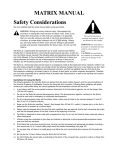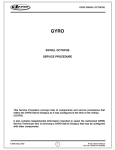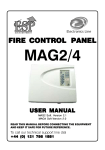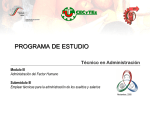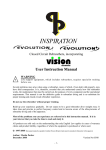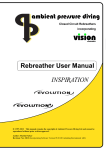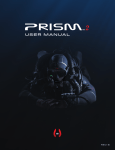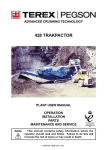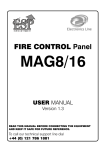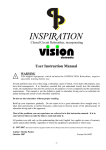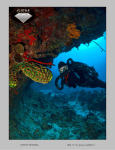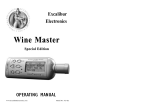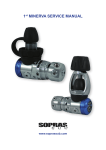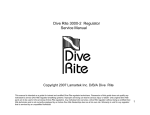Download Azimuth SCR User Manual
Transcript
AZIMUTH REBREATHER 1. SAFETY INFORMATION The Azimuth – a cyclic, semi-closed circuit diving apparatus for Nitrox breathing mixes — is the result of a new NORTHERN DIVER (INTERNATIONAL) LTD project geared to maximum reliability and ease of use. However, like all Nitrox rebreathers, its incorrect use may result in serious injury or death. Before using this rebreather, it is essential to obtain speciality diver certification through a training course conducted by recognised national or international body. This manual is intended as a guide to the correct use of the Azimuth rebreather, however it cannot replace the diver training certification which is essential for the safe use of this equipment. AZIMUTH Under no circumstances should persons who are not certified and trained in the use of this equipment use the Azimuth rebreather. CYCLIC SEMI-CLOSED CIRCUIT DIVING APPARATUS FOR NITROX BREATHING MIXES This manual does not in itself contain all the information necessary for safe use of the Azimuth rebreather, however in conjunction with certification from a training course recognised by Northern Diver (International) Ltd, it permits the safe use of the Azimuth rebreather. This manual also contains the manufacturer’s instructions for routine maintenance of the Azimuth rebreather; failure to comply with these instructions may result in serious injury or death. It is extremely important to read and understand all the information contained in this manual in order to extend the knowledge of the Azimuth rebreather obtained during the specialist training course. This rebreather is constructed and sold exclusively for recreational use, and must be used exclusively for this purpose, within the safety limits indicated below. DANGER WARNINGS This manual includes graphic symbols for highlighting the risks and dangers that can be encountered during the use and maintenance of the Azimuth rebreather. These graphic symbols and their associated captions are: M DANGER Indicates an imminent hazard which, if not avoided, may result in serious injury or death. I M DANGER The Azimuth rebreather can be used only after having obtained the necessary specialist certification from a diver training course approved by Northern Diver (International) Ltd. Azimuth is a semi-closed circuit Nitrox rebreather designed and constructed for recreational diving. It must not be used for diving deeper than 33 meters or for decompression-stop diving. WARNING Indicates a potential hazard which, if not avoided, may result in serious injury or death. G ATTENTION Indicates a potential hazard which, if not avoided, may result in slight or moderate injury. May also indicate the unsafe execution of a procedure. It is essential to make note of these hazard and danger symbols to avoid dangerous situations during the use of the Azimuth rebreather that may result in serious injury or death. The Azimuth rebreather must be regularly checked and overhauled at an authorized Northern Diver (International) Ltd service centre. Any repairs must be carried out by an authorized Northern Diver (International) Ltd service centre, using only original spare parts. The routine maintenance operations described in this manual can be performed by the user, who must carefully follow the procedures indicated. I WARNING It is essential to have the Azimuth rebreather checked and repaired, in accordance with the information contained in this manual, only at authorized Northern Diver (International) Ltd service centres and using only original Northern Diver (International) Ltd spare parts. Failure to comply with this requirement may result in malfunction of the rebreather, with the risk of serious injury or death. The owner is responsible for any malfunction of the rebreather if the apparatus has not been checked and overhauled by an authorized Northern Diver (International) Ltd service centre, or if the rebreather has been used for any purpose other than recreational diving. The owner is responsible for any malfunction of the rebreather if repairs and maintenance have been carried out using non-original spare parts. Northern Diver (International) Ltd declines liability for all damages in the event of failure to comply with the above conditions. I WARNING Do not use the Azimuth rebreather for decompression-stop dives or for diving deeper than 33 meters. Failure to comply with these restrictions may result in serious injury or death. The Azimuth rebreather offers many advantages over traditional open-circuit scuba apparatus. In fact, the regeneration of the breathing mix considerably extends the diver’s air time, allowing him to stay longer at any given depth, and producing fewer bubbles. Because the chemical process which regenerates the breathing mix requires all parts to be in perfect working order, it is necessary to be fully aware of the associated risks before using the rebreather within acceptable safety margins. I WARNING This user manual is NOT a substitute for the specialist diver certification for use of the Azimuth. Do not use the Azimuth until you have obtained the requisite qualification. Use of this rebreather by divers who have not obtained the specific Azimuth certification, even if they hold training certificates for the use of other rebreathers, may result in serious injury or death. The Azimuth rebreather must be used with Nitrox breathing mixes with oxygen percentages of 32%, 40% and 50% in volume terms. Because it is possible to adjust the active-addition rate, the Azimuth rebreather can also be used with different mixes from those specified above; these other mixes should only be used by highly experienced divers, who accept full responsibility for the consequences of their actions. 2. INTRODUCTION The Azimuth cyclic, semi-closed circuit diving apparatus for NITROX breathing mixes is the result of a new project geared to maximum reliability and ease of use. It has been designed, developed and constructed by NORTHERN DIVER (INTERNATIONAL) LTD, a longestablished leader in the field. The Azimuth has been extensively tested both in the prototype and pre-production phases, and consistently fulfilled the highest expectations under all conditions. breathing loop at any time. Each of the two tanks has a pressure reducer connected to its own submersible pressure gauge for monitoring tank pressure. There is also an open circuit regulator for emergency use, in the event of failure of the semi-closed circuit. The Azimuth rebreather is completed by a BC equipped with inflator unit for oral or manual inflation, and with three different air-release systems (deflator button, pulling on the corrugated tube and over-expansion relief valve for the head-down position) The absence of complex and potentially unreliable mechanisms, together with its extremely simple maintenance, make this a simple and rugged diving apparatus which can be used in complete safety. I Constructed from highly sophisticated materials, using innovative production processes and subjected to exhaustive testing, it represents the state-of-the-art in diving systems for NITROX breathing mixes. 3. FUNCTIONAL DESCRIPTION M DANGER WARNING The Azimuth BC is not a life vest and is not designed to hold the head of an unconscious diver out of the water under all conditions. The Azimuth uses oxygen-rich mixtures, commonly known as NITROX, with the following percentages: Breathing mix of 50 % O2 and 50 % N2 for use up to 18 meters Breathing mix of 40 % O2 and 60 % N2 for use up to 25 meters Breathing mix of 32 % O2 and 68 % N2 for use up to 33 meters Divers using the Azimuth rebreather must have received specific instruction concerning the hazards associated with breathing oxygen-rich mixtures (Nitrox), due to both the toxicity of high pressure oxygen (hyperoxia) and the risk of oxygen scarcity (hypoxia). The user should be perfectly aware that this equipment can only be used after obtaining the specialist certification from a training course taught by qualified instructors. This manual is not in any way a substitute for the requisite training. Use of the Azimuth by non-certified divers is dangerous and may result in serious and possibly fatal accidents to the diver and his companions. M The Azimuth model is a cyclic semi-closed circuit rebreather in which the breathing mix moves through a one-way loop and is scrubbed to remove the CO2 from the exhaled gas. Never exceed the maximum permitted depth specified for each mixture. Due to oxygen toxicity, failure to observe these limits puts the diver and his companions at risk of serious or even fatal accidents. DANGER The total absence of sensors or servo-mechanisms assures simplicity of operation. The diver inhales the gas mix contained in the inhalation counterlung through the righthand corrugated hose, and exhales the products of respiration (residual oxygen, nitrogen and carbon dioxide) and water vapour via the mouthpiece and the left-hand corrugated hose, into the exhalation counterlung. A relief valve connected to the exhalation counterlung vents the excess pressure. From the exhalation counterlung, the gas is conveyed into the scrubber unit, which has the function of absorbing and chemically fixing the CO2 contained in the exhaled gas. The gas cleaned by the scrubber flows back into the inhalation counterlung, where it is mixed with a continuous injection of breathing mix from the active addition group. This active addition of new gas completely replenishes the oxygen consumed by the diver’s metabolism. Using the active-addition group, the diver can operate a bypass valve for the manual injection of breathing mix from the tank, and can switch the second tank into the Each mixture requires a specific value of active-addition rate. Before every dive, choose which mixture to use as a function of the maximum planned depth, and then carefully calibrate the active addition unit. These active addition rates are only calculated for the three types of mixtures. M DANGER Only use the Azimuth with the three mixtures specified above. Do not attempt to calculate the active-addition rates for different types of mixtures, as this exposes the diver to serious risks such as hyperoxia and hypoxia, which may lead to serious or fatal accidents for the diver and his companions. Be absolutely certain, by checking personally before each dive, that the mixture and active-addition rate are correct. NOTE: The Azimuth rebreather does allow particularly expert divers to use all types of NITROX mixtures with oxygen percentages ranging from 32 to 50%. However, the user who decides to use a different mixture from the three standard mixes specified in this manual does so at his own risk, and under his own responsibility. I The maximum depths given above have been calculated so as to not exceed an O2 partial Check the tank test date, stamped on the rounded end under the control valve. If the tank is due for testing, replace it. pressure of 1.4 bar. If you are planning to spend more than a few minutes at the maximum depth, it is strongly recommended to reduce the maximum depth so as to never exceed an O2 partial pressure of 1.2 bar. The user should choose the mixture in such a way that decompression stops are not necessary. Safe diving practice advises against using the Azimuth in decompression stop dives. In any case, as is taught in any specialist training course, remember to base your calculations on the maximum permitted depth for the type of mixture used, and to calculate the decompression stops as for normal compressed air. 4. PREPARATION FOR USE Before each dive, go through the following checklist to ensure that the equipment is in correct working order: > Check the tank pressure and if necessary refill with breathing mix to the nominal pressure stamped on the tank > Check the oxygen percentage of the breathing mix to be used > Check the active addition rate of the breathing mix to be used > Check the calibration of the automatic relief valve > Fill or replace the soda lime canister > Check the correct operation of the corrugated hoses and the four-way valve > Check the correct operation of the complete rebreather when ready for use 4.1 CHECKING THE PRESSURE AND REFILLING THE TANKS To check the pressure of the breathing mix, open the tank control valves and read the value on the pressure gauge of each tank. This reading must be the same as the working pressure stamped on the tank body; if this is not the case, proceed to fill the tank as described below: Disconnect the pressure reducer from the tank control valve by unscrewing its knob, then loosen the retaining straps and remove the tank from its compartment place the tank on a filling station, and proceed to refill with the type of mix specified on the tank; DANGER Make sure that the tank is filled with the correct type of mixture. Replace the tank in its compartment, connect its pressure reducer and firmly secure it to the outer shell by means of the retaining straps. WARNING 4.2 CHECKING THE PERCENTAGE OF OXYGEN IN THE BREATHING MIX Connect an oxygen analyser (not supplied with the rebreather) to the tank and check that the gas mix conforms to the required percentages. M DANGER It is essential to personally check the gas mix, as this determines both the correct setting for the active addition rate and the maximum permitted depth. 4.3 CHECKING THE ACTIVE ADDITION RATE OF THE BREATHING MIX To check the active addition rate of the breathing mix, proceed as follows: Disconnect the hose which carries the active addition and manual bypass flow (yellow colour) from the active addition group; Attach the connector hose with flowmeter to the active addition group; Open the lower tank control valve tank to initiate active addition of breathing mix; Allow a few seconds for the addition rate to stabilize, then check that the flow rate measured on the flowmeter coincides exactly with the correct index mark: the correct flow rate for each type of breathing mix is given in the table below: Index Breathing mix Flow rate in litres/minute 3 32% O2 / 68% N2 15.6 2 40% O2 / 60% N2 9.6 1 50% O2 / 50% N2 6.6 If necessary, adjust the active addition rate as follows: > Manually unscrew and remove the knurled cap from the upper part of the active addition group > Slowly turn the adjuster finger in a clockwise direction to increase the flow rate > Slowly turn the adjuster finger in a counter-clockwise direction to reduce the flow rate After obtaining the desired value, check that the flow rate remains stable for a period of approximately one minute. M unit body > Remove the cover and insert the metering funnel inside the canister to perform the filling operation > Fit the special cap in the middle of the filter to prevent soda lime granules from getting into the inner section > Using the funnel, fill the scrubber unit with the soda lime provided, helping it to settle by lightly and repeatedly knocking against the scrubber body with your hand > The correct quantity of soda lime for filling the scrubber unit is approximately 2 kg or up to the level indicated by the metering funnel DANGER Carefully check that active-addition rate is correct for the type of mixture used; a flow rate that is too low or too high may cause serious or even fatal accidents to the diver. 4.4 CHECKING THE CALIBRATION OF THE AUTOMATIC RELIEF VALVE To check the calibration of the automatic relief valve, proceed as follows: > Open the cover of the outer shell > Remove the screw plug from the box of the automatic relief valve > In the place of the plug, manually connect the hose leading to the submersible pressure gauge > Close the four-way valve by lowering the lever > Open the control valve of the lower tank to initiate active addition of breathing mix into the inhalation counterlung at the pre-set rate > When the counterlungs are full, the automatic relief valve opens, making it possible to measure its calibration in millibars on the pressure gauge > The relief valve should open at 14 mbar with a permitted tolerance of +/- 2 mbar; if it is necessary to correct its calibration, simply back off the threaded locking ring on the outer side of the cover. Then slowly screw down the adjusting ring to increase the pressure or unscrew to reduce the pressure M M DANGER Before filling the scrubber unit, check the expiration date of the soda lime. DO NOT use soda lime that has expired. Completely replace all the soda lime each time the tanks are filled. Breathing in a closed loop using expired or exhausted soda lime can be exceedingly dangerous, and may result in serious or even fatal accidents to the diver. > Check that the O-ring seal of the cover is not broken or damaged; replace if necessary > After filling the scrubber unit, remove the funnel and cap, carefully clean the mouth of the scrubber unit to remove any soda lime granules and/or dust, replace the cover and manually lock down the stud > Reassemble the scrubber unit in its compartment and secure with its retaining straps, without pulling them tight > Reconnect the scrubber unit to the counterlungs by means of the special locking rings on the fittings > Fully tighten the retaining straps fixing the scrubber unit to the shell DANGER Always ensure that the automatic relief valve is calibrated within the specified range; do not attempt to use different calibrations; a different pressure value may lead to malfunction of the counterlungs, putting the diver at risk of serious or even fatal accidents. 4.5 FILLING THE SCRUBBER UNIT WITH SODA LIME To fill the scrubber unit with soda lime, proceed as follows: > Open the cover of the outer shell > Loosen the retaining straps of the scrubber unit, manually unscrew the locking rings of the counterlung fittings, open the straps and remove the scrubber unit from the shell > Place the scrubber unit in a vertical position on a stable surface, with the cover facing upward > Manually unscrew the stud to automatically raise the cover off the scrubber 4.6 CHECKING THE OPERATION OF THE CORRUGATED HOSES AND THE FOUR-WAY VALVE To check the operation of the corrugated hoses and the four-way valve, proceed as follows: > Place the rebreather in the vertical position, resting it on its special support, and fully open the rear cover > Check that the coloured bands on the corrugated hose connectors are correctly matched up with those on the fittings on the outer part of the shell > Place the mouthpiece of the four way valve in your mouth > With the lever in the open position (up) inhale deeply from the mouthpiece > Move the lever to the closed position (down) and exhale through the mouthpiece > Repeat this operation several times until the counterlungs are completely collapsed > Move the lever to the open position (up) and exhale completely so as to inflate the exhalation counterlung (when wearing the rebreather, this is the counterlung behind the left shoulder > Inhale until the exhalation counterlung collapses again and the inhalation counterlung increases in volume (when wearing the rebreather, this is the counterlung behind the right shoulder) I 5. USING THE REBREATHER After having checked the correct operation of the various rebreather components, proceed to don the unit and begin the dive as follows: > Position the rebreather in the vertical position, resting it on its special support, and adjust all the harness straps to their maximum length > Don the rebreather by putting your arms through the shoulder straps > Adjust the shoulder straps to the desired length, using the “D” rings at the front > Fasten the buckle of the cummerbund > Fasten the buckle of the chest strap > Fasten the leg straps > Proceed to correctly adjust the straps so that the rebreather shell adheres close to the body without hampering your movements > Place the four-way valve lever in the closed (down) position WARNING Failure of the system to operate as described above indicates incorrect assembly of the check valves or the corrugated hoses, which can be extremely dangerous during the dive. 4.7 FINAL CHECK OF THE OPERATION OF THE REBREATHER Open the cover of the shell to expose the counterlungs. Open both tank control valves and check for any leaks in the counterlungs or in the other components by submerging the rebreather in water with the four-way valve closed (lever in down position). Check that the emergency regulator and the BC are working correctly. G M DANGER Proceed with these final steps of the preparations only if you are ready to go into the water. If any anomalies in the rebreather’s operation are found during this final check, postpone the planned dive until the problem has been completely resolved. Starting a dive with a rebreather that is not in perfect working order is extremely dangerous, and puts the diver at risk of serious or even fatal accidents. In case of: Air leak from counterlungs; Replace or repair Air leak from pressure reducer / tank control valve fitting; Replace the O-Ring seal of the connector in the tank control valve fitting Air leak from four way valve; Replace the four way valve assembly Air leak from corrugated hoses Disassemble and inspect the corrugated hoses and the O-rings of the counterlung fittings, replace the O-rings if necessary No pressure reading from the pressure gauge(s); Tank empty - Proceed to refill Pressure gauge or hose defective - Replace Water leaks in through the mouthpiece; Mouthpiece broken or split - Replace Four way valve to be cleaned or replaced ATTENTION > Make sure that the cam of the active addition group is in the closed position > Slowly turn the control valve of the upper tank to the fully open position > Slowly turn the control valve of the lower tank to the fully open position G CAUTION When the control valve of the lower tank is opened, the active addition group start to deliver breathing mix into the inhalation counterlung. Delaying the dive at this point would therefore lead to a waste of breathing mix; for this reason it is advisable to open the lower tank control valve only for the duration of the pre-dive checks, and then again at the moment of starting the dive. > Check the operation of the emergency regulator by inhaling and exhaling through its’ mouthpiece > Check the operation of the BC inflator and deflator controls > Check both submersible pressure gauges to ensure that the tanks are correctly filled; > Place the mouthpiece in your mouth > Exhale fully through the mouthpiece, to expel the air contained in your lungs, with the four way valve in the closed position (lever down) > Open the four way valve after having exhaled as described above (lever up) > Check that you can inhale and exhale deeply from the mouthpiece without any effort or obstruction > Check the operation of the manual injection control, by slightly pressing the palm lever of the active addition group bypass valve > Submerge just enough to make a final check of buoyancy and general comfort; > When all the checks have been successfully completed, it is possible to start the dive. > During the dive, when the lower tank pressure gauge (each gauge must be clearly identified with a different coloured cover) reading approaches 20 bar, it is necessary to switch the upper tank into the breathing loop by rotating the active addition group cam to the all-forward position. M 6. ROUTINE MAINTENANCE Immediately after every dive: > Open the cover of the shell and rinse the rebreather, with the four way valve closed, using plenty of fresh water > Rinse the regulator 2nd stage in plenty of fresh water, without pressing the purge button to prevent water from going inside > Remove the soda lime scrubber unit > Empty the soda lime, then rinse the scrubber unit with fresh water, blow dry with compressed air and remove any fragments of soda lime granules from the holes > Disassemble the corrugated hoses and the four way valve; wash them thoroughly in plenty of fresh water, disinfect with a NORTHERN DIVER (INTERNATIONAL) LTD antibacterial solution (or equivalent product), rinse, pack down the corrugated hose coils to squeeze out as much water as possible, and allow to dry > Disconnect the 1st stage regulator valves (pressure reducers) from the tanks and remove the tanks DANGER The user must be perfectly aware that it is absolutely essential to constantly check the tank pressure during the dive: it is extremely dangerous to continue breathing in the closed loop with a tank pressure of less than 20 bar. The secondary tank can be switched into the loop at any time, without necessarily waiting for the primary tank to be empty. Failure to observe these precautions can be extremely dangerous, and may cause serious or even fatal accidents to the diver. Before abandoning the mouthpiece, underwater or on the surface, it is essential to close the four-way valve by placing its lever in the down position. To resume breathing from the mouthpiece underwater, proceed as follows: > Place the mouthpiece in your mouth with the four way valve closed (lever in down position) > Blow forcefully into the mouthpiece to expel the water from its small inner chamber > Place the four-way valve lever in the up position (open) and start breathing M DANGER It is extremely dangerous to lose contact with the mouthpiece underwater without having first closed the four-way valve, by placing the lever in the down position. The resulting infiltration of water into the breathing loop may cause the rebreather to malfunction. A sudden negative-buoyancy situation may indicate that part of the breathing loop has collapsed, with consequent flooding. In these cases, it is essential to switch to the emergency regulator and interrupt the dive. Failure to observe these cautions can be extremely dangerous, and puts the diver at risk of serious or even fatal accidents. At the end of the dive, close the tank control valves and check that, after approximately one minute, the active addition flow ceases and the pressure gauges indicate zero bar. Vent the pressure from the emergency regulator by pressing the purge button on the front. Vent the pressure from the BC inflator group by pressing the inflation button. G CAUTION Fit the special dust caps on the pressure reducers to prevent water from going inside. > Disconnect the counterlungs from the upper counterlung fittings and from the hose with quick coupling; remove the counterlungs > Remove the drain cap from the counterlungs; wash and rinse thoroughly with plenty of fresh water and disinfect using products as above; > Allow all the rebreather components to dry in a well-ventilated shady area; > Lightly lubricate all the O-ring seals with type FOMBLIN YNX or CHRISTO-LUBE oxygen-compatible grease NORTHERN DIVER (INTERNATIONAL) LTD APPLEY LANE NORTH APPLEY BRIDGE LANCASHIRE WN6 9AE TEL: 01257 254444 FAX: 01257 251234 Website: www.ndiver.com email: [email protected]








